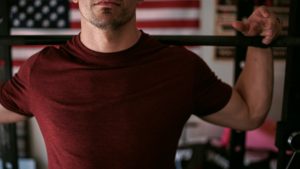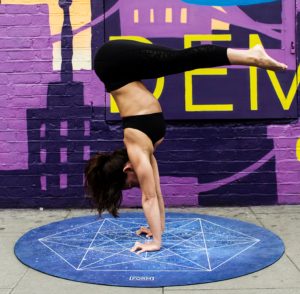Getting Strong in The Gym Matters for Every Fitness Goal
Whether you want to look, feel, or perform your best – or all three – your first priority should be getting as strong as possible. Strength is the basis for everything else in the gym… including looking better in your bathing suit.
I’ll never forget the moment I met a particular gym member. He was a good-looking young guy, in his late twenties. We’ll call him Rob.
 This was one of the first personal training consultations I ever held. Rob sat across the desk from me and told me about his training. He’d been in the gym for years and knew his way around a squat rack. So, I asked the obvious question: what do you want to get out of your personal training session today? His answer almost made me lose my professional composure. “I want to look better naked.”
This was one of the first personal training consultations I ever held. Rob sat across the desk from me and told me about his training. He’d been in the gym for years and knew his way around a squat rack. So, I asked the obvious question: what do you want to get out of your personal training session today? His answer almost made me lose my professional composure. “I want to look better naked.”
Ding, ding!
Let’s be honest – most people who walk into a gym do it because they want to look better in skinny jeans, tank tops, bathing suits, or their birthday suit. But most people never vocalize that goal. They say they want to lose weight… okay, that’s fine. But why?
What does some number on a scale even mean? Why is it significant that you see 135# staring back at you instead of 138# or whatever – it’s just a number. If your goal is to look better naked, it doesn’t matter what the scale says.
Lifting weights is the BEST way to get fit, lose weight, tone up, etc.
It literally does not matter how you phrase your ultimate fitness goal, lifting weights is the best way to get there. Lifting weights makes you stronger, stronger people are healthier, and healthy people just look damn good.
I cannot over stress the importance of training for strength if you want to look good naked.
 But what does being “strong” mean, really?
But what does being “strong” mean, really?
Physical strength can be divided into several categories:
- Absolute vs relative strength
- Power (speed-strength) vs strength endurance
Absolute strength is the total measure of how much resistance you can overcome. Think “300-lb back squat.” Someone that can move three hundred pounds is pretty strong.
On the other hand, relative strength refers to how much resistance you can overcome compared to your bodyweight. A 5’3” 120-lb athlete who can deadlift three hundred pounds has greater relative strength compared to a 6-ft, 200-lb athlete who can deadlift the same weight. Pound for pound, the smaller athlete has more relative strength.
Then there are the types of strength we can express.
Olympic lifters train for explosive strength – the ability to generate force quickly to move a heavy barbell from the floor to over their heads. This requires a ton of technical proficiency and mobility, but also a lot of “speed-strength.”
Similarly, powerlifters compete to see who can move the heaviest weights. That requires the ability to generate massive amounts of force to overcome the resistance of a heavy barbell during squats, deadlifts, and the bench press. But you only need to move the bar for one repetition.
Conversely, the term “strength endurance” refers to an athlete’s ability to repeatedly overcome resistance, as during a 20-rep squat or completing as many pull ups as possible in one set.
Ok, now that we’ve defined “strength,” we can talk about why it matters.
Strength training involves overcoming some sort of resistance, whether that resistance comes in the form of your body during a push up, or a barbell during a bench press. Repeatedly lifting a load creates new connections between your central nervous system (CNS) and your muscle fibers. Your CNS learns to send signals to your muscles so they fire faster, better, and in coordination to execute technical movements.
 Strength training essentially opens the door to what your body is capable of. Without strength training (bodyweight training included), you probably aren’t as coordinated because your CNS and muscle fibers aren’t used to working together. Tally one win for strength training: it literally makes you better at controlling your own body. That’s kind of a big deal.
Strength training essentially opens the door to what your body is capable of. Without strength training (bodyweight training included), you probably aren’t as coordinated because your CNS and muscle fibers aren’t used to working together. Tally one win for strength training: it literally makes you better at controlling your own body. That’s kind of a big deal.
Another reason strength matters is because we naturally lose muscle mass as we age. This is called sarcopenia (muscle wasting). Muscle isn’t the only tissue that deteriorates with time. We also naturally lose bone density as we age; women more so than men. Resistance training improves bone density, helping you avoid hip fractures and assisted living homes in your golden years. Chalk up another win for resistance exercise. (1)
Ok, you’re reading this in your twenties and thirties, thinking who cares about osteoperosis. I get that. But consider this: decreased muscle mass contributes to the dreaded metabolic slowdown that people begin to notice in their thirties. You know what I mean if you’ve ever heard someone complain, “I just can’t eat like I used to… if I even look at cookies/chips, I gain five pounds.”
 This metabolic slow-down occurs because your muscle mass powers your metabolism. You could even say that “muscle IS metabolism” – it’s that important. Muscle mass contributes approximately 20% to your total daily energy expenditure; compare this to body fat, which contributes only 5% to total energy expenditure. (2)
This metabolic slow-down occurs because your muscle mass powers your metabolism. You could even say that “muscle IS metabolism” – it’s that important. Muscle mass contributes approximately 20% to your total daily energy expenditure; compare this to body fat, which contributes only 5% to total energy expenditure. (2)
Your muscles use FOUR TIMES more energy than your body fat stores do. Let me say that again: muscles burn four times more energy than body fat!
You want to lose weight? Lift weights. Get strong. Build muscle. Your body will automatically burn more calories if you carry around more lean muscle mass.
As if having an efficient central nervous system, avoiding bone loss, and retaining muscle to rev your metabolism aren’t compelling enough for you to lift weights, think about this: everything in life becomes easier when you are strong.
From carrying all of your groceries in one trip to crushing double black diamonds all day, you need a strong body to perform well at life. I don’t care if you’re a weekend warrior or desk jockey, being a physically strong human being is freaking important.
How much strength can you expect to gain when you start lifting weights?
Let’s use the deadlift as an example because it’s my favorite exercise, and its execution requires every muscle in your body, making it a good indicator of full-body strength.
Complete beginners can generally learn to deadlift about 50-60% of their bodyweight (women) or a barbell loaded equally to their bodyweight (men). With dedicated training, intermediate female lifters can work up to deadlifting about one-and-a-half times their body weight; intermediate male lifters can work up to 1.75-1.9 times their body weight. Advanced and elite athletes can deadlift two to three times the weight of their bodies, usually for a single repetition, or one-rep max. (3)
What about differences between men and women lifters? According to an incredibly thorough review of the available scientific literature, Greg Nuckols of “Stronger By Science” has concluded that there are marginal differences in strength gains and muscle growth between men and women; though, surprisingly, women may have a slight edge in both strength and muscle growth relative to their starting size, since women tend to be smaller and less muscular before starting a strength training program. (4)
How strong do I really need to be?
First, master your own body weight. Learning the proper form on push ups, pull ups, squats, and lunges will help you progress safely when you transition to strength training. Once you’re confident you can move yourself with proper form, start using weights for resistance to build serious strength.
You only “need” to be as strong as it makes sense for your activity level, which means that strength goals are different for everyone. There are three general strength training goals: wanting to get as strong as possible for the sake of it, wanting to increase athleticism, and simply wanting to look better naked.
Strength train because you want to throw around heavy weights. A single repetition, double-bodyweight deadlift is an impressive feat which can take years to work up to. Not everybody cares to dedicate the necessary training time to accomplishing this feat; nor does the average person need to do so.
Better, and safer, measures of your strength are your 3-rep (3RM) or 5-rep maximum (5RM). These indicate the maximum amount of weight you can lift for three or five repetitions, respectively.
Strength training to increase athleticism. Rep maximums are cool, and all, but nothing is quite so good at showing an athlete’s relative strength as bodyweight exercises. Exercises like push-ups, pull-ups, chin-ups, dips, pistol squats, and other bodyweight movements are a fantastic way to train your relative strength and increase athleticism.
Strength training to look better naked. If your main reason for hitting the gym is to look good, getting strong in the eight-rep to twelve-rep range should be your mission. When you can move moderately heavy weights in that repetition range, you’ll be able to torch body fat and build lean muscle so you look better naked.
Which is more important – absolute strength or relative strength?
Remember back to my training client Rob, who we met in the introduction. He just wanted to lift weights to look better naked. I wager that most of us have that in common with Rob. Many of us don’t really care about our 1RM back squat. We just want to look and feel good. And many of us want to perform to the best of our abilities at fun stuff outside of the gym, like skiing, climbing, or rec volleyball.
Does that mean that weight training for pure strength is useless? Not at all.
While bodyweight movements have immediate carryover to everyday life and recreational sports because being able to control your body in space makes you a better athlete, simultaneously training to develop strength using dumbbells, kettlebells, and barbells can accelerate your athleticism beyond that of bodyweight training alone.
 The bottom line? Train for strength using both your own body and using free weights if you want to look, feel, and perform your best.
The bottom line? Train for strength using both your own body and using free weights if you want to look, feel, and perform your best.
I hope all of this talk about absolute strength, relative strength, and the benefits of weightlifting have convinced you, if you didn’t already believe, that resistance training is dope.
But there’s one thing I’ve failed to discuss so far…
None of this information about the physical benefits of weightlifting takes into account the mental strength required to improve these physical qualities.
The truth is, weightlifting is hard. Sometimes it sucks. And because results don’t happen overnight, strength training requires patience and consistent practice. A consistent strength training routine enhances your discipline and your mental fortitude. It teaches you that nothing worth having comes easily, whether that’s a toned body you build in the gym, or a brilliant career you work for outside of the squat rack. Weightlifting teaches you to shut up and work.
There’s a reason many people never pick up weights – it can be intimidating. But I promise you, it’s worth it. Lifting weights can sculpt your body, sharpen your mind, and change your life.
I believe so strongly in the power of weightlifting to change your life, I put together a free guide to show you exactly what to focus on in the gym to become a leaner, stronger, more badass human. Grab your guide below ????
[activecampaign form=23]
REFERENCES
(1) “The effects of progressive resistance training on bone density: a review.”
(2) “Controversies in Metabolism”
(3) Weightlifting Strength Standards
(4) “Strength Training For Women: Setting the Record Straight”

